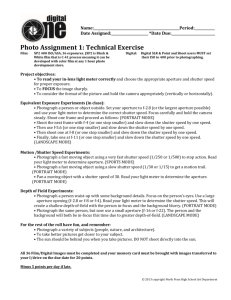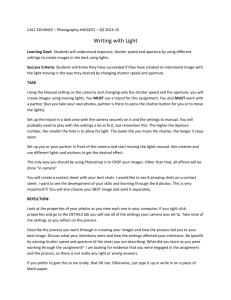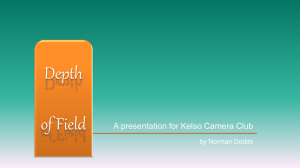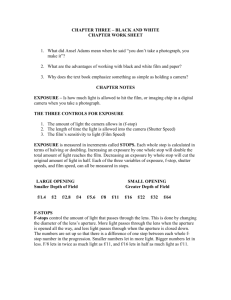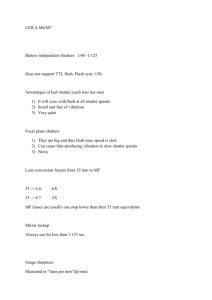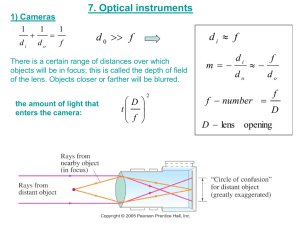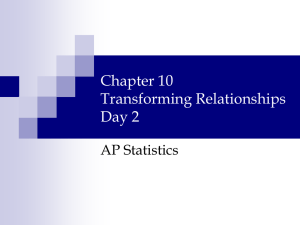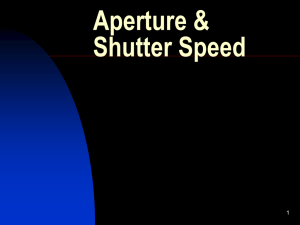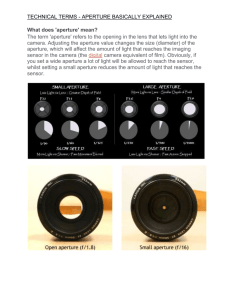Exposure Compensation
advertisement
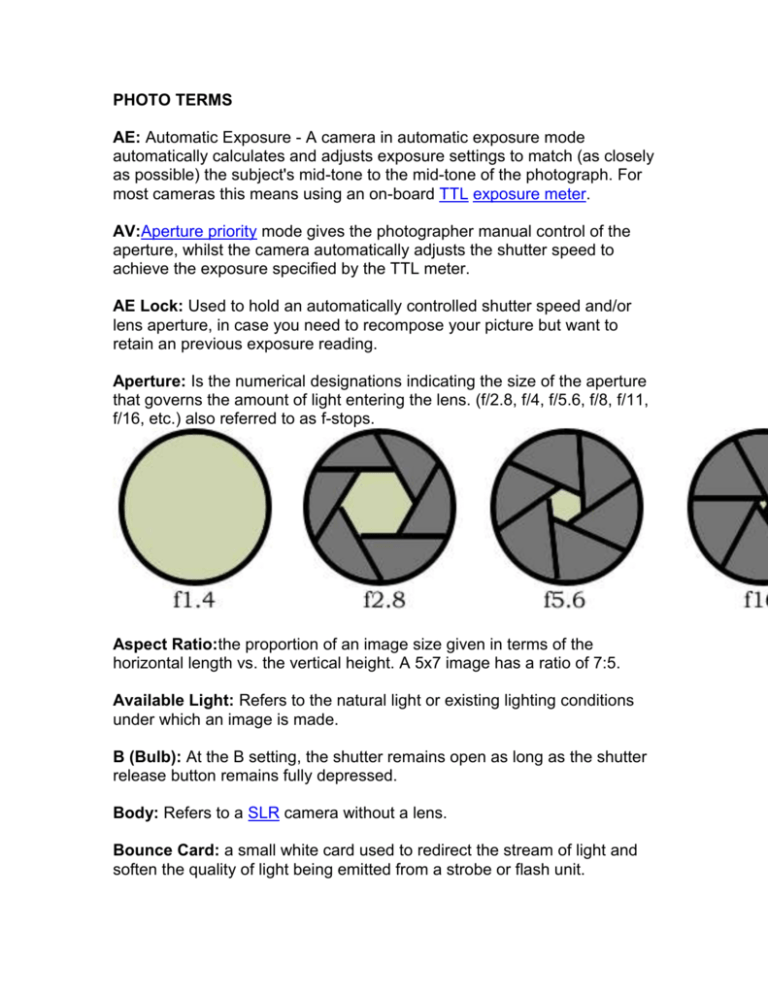
PHOTO TERMS AE: Automatic Exposure - A camera in automatic exposure mode automatically calculates and adjusts exposure settings to match (as closely as possible) the subject's mid-tone to the mid-tone of the photograph. For most cameras this means using an on-board TTL exposure meter. AV:Aperture priority mode gives the photographer manual control of the aperture, whilst the camera automatically adjusts the shutter speed to achieve the exposure specified by the TTL meter. AE Lock: Used to hold an automatically controlled shutter speed and/or lens aperture, in case you need to recompose your picture but want to retain an previous exposure reading. Aperture: Is the numerical designations indicating the size of the aperture that governs the amount of light entering the lens. (f/2.8, f/4, f/5.6, f/8, f/11, f/16, etc.) also referred to as f-stops. Aspect Ratio:the proportion of an image size given in terms of the horizontal length vs. the vertical height. A 5x7 image has a ratio of 7:5. Available Light: Refers to the natural light or existing lighting conditions under which an image is made. B (Bulb): At the B setting, the shutter remains open as long as the shutter release button remains fully depressed. Body: Refers to a SLR camera without a lens. Bounce Card: a small white card used to redirect the stream of light and soften the quality of light being emitted from a strobe or flash unit. Bracketing: A common photographic approach whereby the photographer will take several frames of the same scene at different exposure settings. Composition: the arranging of informational and/or artistic elements with a viewfinder so as to form a unified whole or image that imparts information or an idea. Computer Enhancement: refers to contrast adjustments, toning, color correcting dodging and burning to prepare an image or photograph for production. Computer Image: pure digital illustration -- created on a computer to achieve a particular effect -- which either uses photographs as its base material, or is so photorealistic that it may be perceived as being real. The images are not real events that have occurred in history but rather are manifestations of ones imagination. Depth of Field: simply put, it is the apparent sharpness of a photograph considering the distance between the nearest and farthest elements that appear to maintain acceptable sharpness and clarity. Digital Photograph: A photograph that has been captured electronically on a hard drive (storage device) or converted from film to digital format through an electronic scanning process. Dodging and Burning: Is the lightening (burning) and darkening (dodging) of areas of the photograph by altering the amount of light hitting the print. Dynamic Range: refers to the varying gray values, or the spread of gray values, in an image that are possible reproduction. Am image with a high dynamic range suggests a wide number of gray levels and is normally associated with good contrast levels. EOS (Canon): Electronic Optical System; Canon's current line of autofocus cameras and accessories. Was introduced in 1989 to facilitate the new Canon autofocus system. E-TTL (Canon): Evaluative, through-the-lens flash metering. EV: Exposure Value denotes all combinations of a camera's shutter speed and relative aperture that give the same exposure. In an attempt to simplify choosing among combinations of equivalent camera settings, the concept was developed by the German shutter manufacturer Friedrich Deckel in the 1950s. Exposure value also is used to indicate an interval on the photographic exposure scale, with 1 EV corresponding to a standard power-of-2 exposure step, commonly referred to as a stop. Exposure: is the total amount of light allowed to fall on the photographic medium (photographic film or image sensor) during the process of taking a photograph. Exposure is measured in lux seconds, and can be computed from exposure value (EV) and scene luminance over a specified area. To work with exposure, one must understand how aperture, shutter speed and ISO interrelate. This is often called the Trinity of Exposure. Exposure Compensation: is a technique for adjusting the exposure indicated by a photographic exposure meter, in consideration of factors that may cause the indicated exposure to result in a less-than-optimal image. Factors considered may include unusual lighting distribution, variations within a camera system, filters, non-standard processing, or intended underexposure or overexposure. Cinematographers may also apply exposure compensation for changes in shutter angle or film speed (as exposure index), among other factors. Use this link to see an interactive simulation of Exposure Composition. F-Stops: Is the numerical designations indicating the size of the aperture that governs the amount of light entering the lens. (f/2.8, f/4, f/5.6, f/8, f/11, f/16, etc.) See Aperture. Fast Lens: Refers to lenses that open to a large f-stop (aperture setting). The larger f-stops (smaller numbers, i.e. f/2.8) allow greater amounts of light into the lens. Fill-Flash: is a photographic technique used to brighten deep shadow areas, typically outdoors on sunny days, though the technique is useful any time the background is significantly brighter than the subject of the photograph, particularly in backlit subjects. To use fill flash, the aperture and shutter speed are adjusted to correctly expose the background, and the flash is fired to lighten the foreground. Fisheye: is a wide-angle lens that takes in a broad, panoramic and hemispherical image. Originally developed for use in meteorology to study cloud formation and called "whole-sky lenses", fisheye lenses quickly became popular in general photography for their unique, distorted appearance. They are often used by photographers shooting broad landscapes to suggest the curve of the Earth. Flare: Image degradation caused by stray light which passes through the lens but is not focused to form the primary image. Often caused by light bouncing off internal air-to-glass surfaces. Focal Length: The distance from the optical center of a lens to the image plane when the lens is focused to infinity. Hot Shoe: is a mounting point on the top of a camera to attach a flash unit. In-Camera Manipulation: refers to certain measures and steps taken by the photographer to produce a desired effect, such as filers, lens choice, angles, and/or multiple exposures. ISO: International Standards Organization; the number represents the film's sensitivity to light. A higher ISO number indicates the film is more sensitive and requires less light for a proper exposure. Check this link to see the difference between ISO speeds. Juxtaposition: the act of placing or positioning items in the image area of a photograph side by side or next to one another to illustrate some comparison. Long Glass: refers to a Telephoto lens that magnifies the subjects in an image and covers a narrow angle of view of a scene. Latitude: The variance from "proper" exposure, which will still provide acceptable results. Matrix: This metering mode was first introduced by the Nikon FA, where it was called Automatic Multi-Pattern metering. On a number of cameras this is the default/standard metering setting. Here the camera measures the light intensity in several points in the scene, and then combines the results to find the settings for the best exposure. Moment: Photographers seek to capture the natural and candid events of history. Their quest to capture a "moment" comes from the famous French documentary photographer Henri Cartier-Bresson and his consistent ability to capture the decisive moment in time without disrupting a particular situation. Photo Illustration: is either a set-up photograph (usually in a studio with no digital alteration) that is illustrative in nature and is clearly out of the realm of reality. Traditionally, it is an approach used for fashion, food and product photographs. Photojournalism: is the craft of employing photographic storytelling to document life: it is universal and transcends cultural and language bounds. Pixel: fundamental picture element of a digital photograph. A single digital or electronic photograph is made up of thousands of pixels. Rule of Thirds: is a compositional rule of thumb in visual arts such as painting, photography and design.[1] The rule states that an image should be imagined as divided into nine equal parts by two equally-spaced horizontal lines and two equally-spaced vertical lines, and that important compositional elements should be placed along these lines or their intersections.[2] Proponents of the technique claim that aligning a subject with these points creates more tension, energy and interest in the composition than simply centering the subject would. Seeing Light: refers to the ability of the photographer to see and capture the effects of light and shadow in the world around us. Shooter: A term that has long been associated with newspaper photographers. Today the term is rather controversial. Many journalist feel that the term does not acknowledge the valuable contributions of the photojournalist or news photographer. Shutter Speed: is a common term used to discuss exposure time, the effective length of time a camera's shutter is open. Shutter speed controls the motion seen in a photo. A faster shutter speed will stop action, while a slower shutter speed will blurr movement. SLR: Single Lens Reflex; a camera with one lens (as opposed to Twin Lens Reflex like the Rolleiflex) that involves a mirror and prism that the viewer looks through (as opposed to a point and shoot or rangefinder where the viewer looks through a separate viewfinder. Soft Vs. Sharp: soft is a description for an image that is blurred or out of focus, just as sharp describes an image or part of an image that shows crisp detail and precise texture. Spot Meter: The camera will only measure a very small area of the scene (between 1-5% of the viewfinder area). This will typically be the very center of the scene, but some cameras allow the user to select a different offcenter spot, or to recompose by moving the camera after metering. Strobe: is an electronic flash device that provides artificial, supplementary lighting. Sunny-16 Rule: A guideline that states that you can expose a normal scene, lit by bright sunlight, at an aperture of f16 and a shutter speed equivalent to the film speed (ISO or ASA) being used. TTL: Through-the-lens; commonly used when referring to metering through the lens as opposed to via a separate meter. Effective for fill-flash and other tricky lighting situations. TV: Shutter priority mode gives manual shutter control, with automatic aperture compensation. In each case, the actual exposure level is still determined by the camera's exposure meter. Transmit: The process of sending a photograph from one location to another via computer or cell phone. Wild Art: Stand-Alone, Feature Shot, Enterprise art are found moments that are intended to be realistic slices of everyday life. Zone System: An early application of exposure compensation was the Zone System developed by Ansel Adams and Fred Archer.[2] Although the Zone System has sometimes been regarded as complex, the basic concept is quite simple: render dark objects as dark and light objects as light, according to the photographer's visualization. Developed for blackand-white film, the Zone System divided luminance[# 5] into 11 zones, with Zone 0 representing pure black and Zone X representing pure white. The meter indication would place whatever was metered on Zone V, a medium gray. The tonal range of color negative film is slightly less than that of black-and-white film, and the tonal range of color reversal film and digital sensors even less; accordingly, there are fewer zones between pure black and pure white. The meter indication, however, remains Zone V. The relationship between exposure compensation and exposure zones is straightforward: an exposure compensation of one EV is equal to a change of one zone; thus exposure compensation of −1 EV is equivalent to placement on Zone IV, and exposure compensation of +2 EV is equivalent to placement on Zone VII. The Zone System is a very specialized form of exposure compensation, and is used most effectively when metering individual scene elements, such as a sunlit rock or the bark of a tree in shade. Many cameras incorporate narrow-angle spot meters to facilitate such measurements. Because of the limited tonal range, an exposure compensation range of ±2 EV is often sufficient for using the Zone System with color film and digital sensors. Zoning: Presetting the focus to a particular spot to photograph action so that the area where the action is anticipated to take place will be in focus.

